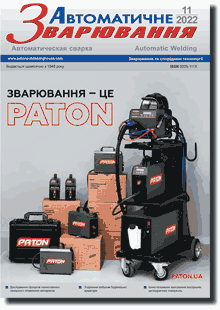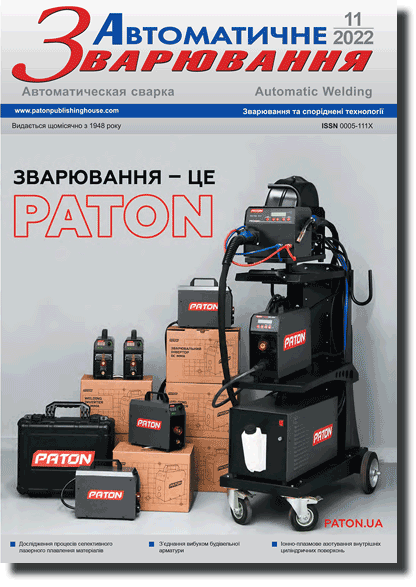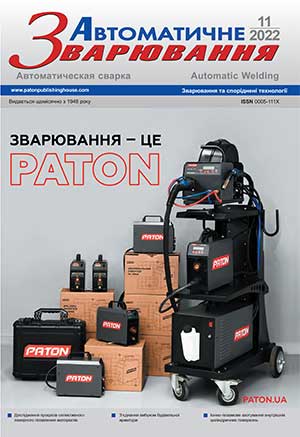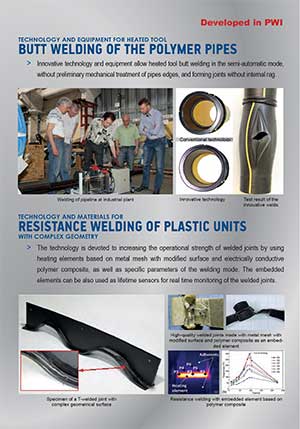| 2022 №11 (06) |
DOI of Article 10.37434/as2022.11.07 |
2022 №11 (08) |

"Avtomatychne Zvaryuvannya" (Automatic Welding), #11, 2022, pp. 45-51
Control of energy parameters of plasma flows of N–O–C–H system
V.M. Pashchenko
NTUU «Igor Sikorskyi Kyiv Polytechnic Institute». 37 Peremohi Ave., 03056, Kyiv, Ukraine. E-mail: vn.paschenko@ukr.net
The methods to control the plasma flow parameters by changing the geometrical dimensions of the arc channel and superposition of external magnetic fields are discussed. The possibility of increasing the temperature level in the entire volume of plasma flow of N–O–C–H system in the case of increasing the diameter of nozzle opening of the arc channel and compensating the speed losses without deterioration of temperature characteristics due to a simultaneous increase of plasma-forming mixture flow rate is shown. The effectiveness of application of external transverse magnetic fields for harmonizing the relative position of separate phases of the heterogeneous flow at thermal deposition of the coating was proved. It is shown that transverse field application shifts the spatial position of the high-temperature zone of the plasma flow by 1…12° relative to arc channel axis. Under the condition of radial feed of the initial material, when the channels of mass transfer of the gas and condensed phases of the twophase flow do not coincide, it allows increasing the volume of spray-deposited material by 1.5…1.7 times, due to penetration of the greater part of the initial material into the active zone of the flow. Dependence of energy parameters of plasma generator and dimensions of the high-temperature gas jet on the frequency of rotation of the external rotating magnetic field and current in electromagnet windings was studied. It was established that optimization of the rotating field parameters allows significantly (up to 20 %) raising the arc voltage parameters and increasing the volume of the high-temperature zone by 25…30 % with simultaneous equalizing of the parameters over the plasma flow cross-section. 8 Ref., 8 Fig.
Keywords: plasma generator, arc channel, plasma-forming mixture of air with hydrocarbon gas, temperature and speed profiles of the flow, active zone dimensions, external transverse magnetic field, angle of flow deviation, external rotating magnetic field
Received: 26.09.2022
References
1. Borisov, Yu.S., Vojnarovich. S.G., Kislitsa, A.N. et al. (2017) Development of technology of microplasma spraying for restoration of local damages of enamel coating. The Paton Welding J., 7, 28-32. https://doi.org/10.15407/tpwj2017.07.062. Borisov, Yu.S., Vojnarovich, S.G., Kislitsa. A.N., Kalyuzhny, S.N. (2016) Influence of technological factors of microplasma spraying of TiO2 on the degree of spraying material utilization. The Paton Welding J.,, 10, 46-47. https://doi.org/10.15407/tpwj2016.10.10
3. Ryzhov, R.M., Kuznetsov, V.D. (2010) Magnetic quality control of welded joints. Kyiv, Ekotekhnologiya [in Ukrainian].
4. Razmyshlyaev, O.D., Ahieieva, M.V., Bilyk, O.G., Khaled, E. (2021) Influence of longitudinal control magnetic field on efficiency of arc surfacing process. Automatic welding, 8, 9-13
5. Kachinskiy, V. (2012) Magnetically-impelled arc butt welding for manufacture of hollow parts of mass production. Welding Technology J. Japan, 60.
6. Hua, A., Yin, S., Chen, S. et al. (2010) Behavior of arc and drop transfer of MAG welding controlled by longitudinal magnetic field. J. of Mechanical Engineering. 46(14), 95-100. https://doi.org/10.3901/JME.2010.14.095
7. Dautov, G.Yu., Dzyuba, V.L., Karp, I.N. (1984) Plasmatrons with stabilized electric arcs. Kyiv, Naukova Dumka [in Russian].
8. Pashchenko, V.M. (2018) Arc generators in technologies of surface engineering. Kharkiv, Machulin [in Ukrainian].
Advertising in this issue:
The cost of subscription/purchase order journals or individual articles
| Journal/Currency | Annual Set | 1 issue printed |
1 issue |
one article |
| TPWJ/USD | 384 $ | 32 $ | 26 $ | 13 $ |
| TPWJ/EUR | 348 € | 29 € | 24 € | 12 € |
| TPWJ/UAH | 7200 UAH | 600 UAH | 600 UAH | 280 UAH |
| AS/UAH | 1800 UAH | 300 UAH | 300 UAH | 150 UAH |
| AS/USD | 192 $ | 32 $ | 26 $ | 13 $ |
| AS/EUR | 180 € | 30 € | 25 € | 12 € |
| SEM/UAH | 1200 UAH | 300 UAH | 300 UAH | 150 UAH |
| SEM/USD | 128 $ | 32 $ | 26 $ | 13 $ |
| SEM/EUR | 120 € | 30 € | 25 € | 12 € |
| TDNK/UAH | 1200 UAH | 300 UAH | 300 UAH | 150 UAH |
| TDNK/USD | 128 $ | 32 $ | 26 $ | 13 $ |
| TDNK/EUR | 120 € | 30 € | 25 € | 15 € |
AS = «Automatic Welding» - 6 issues per year;
TPWJ = «PATON WELDING JOURNAL» - 12 issues per year;
SEM = «Electrometallurgy Today» - 4 issues per year;
TDNK = «Technical Diagnostics and Non-Destructive Testing» - 4 issues per year.









